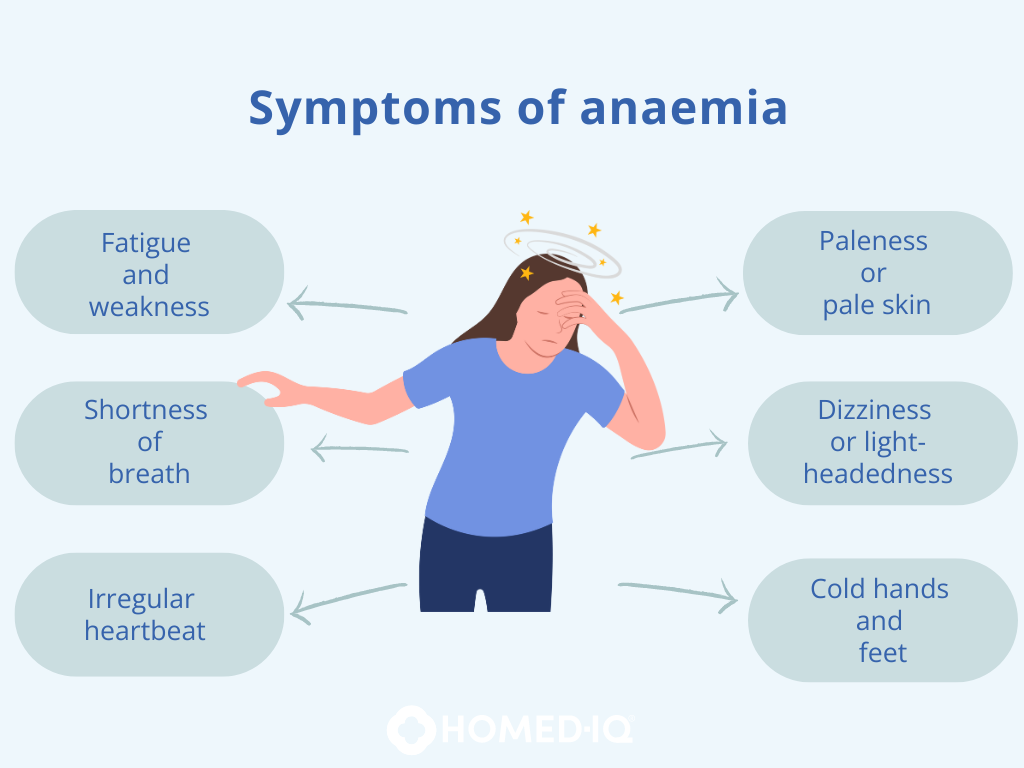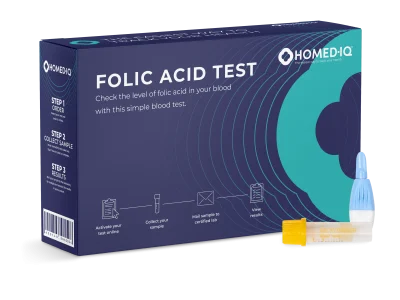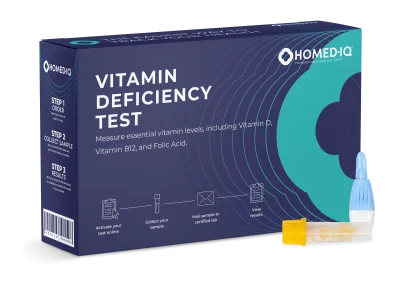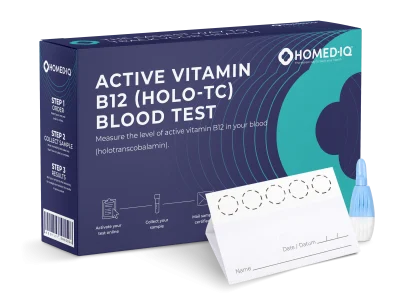Anemia is a common condition that occurs when the body does not produce enough healthy red blood cells, or there is a deficiency of hemoglobin, the protein in blood cells responsible for oxygen transport. Do you often feel tired, less capable, or noticeably pale? These symptoms are often attributed to lack of sleep or stress but can also be signs of anemia. Indeed, 37% of pregnant women and 30% of women between 15 and 49 years globally suffer from anemia, highlighting the importance of a better understanding of this condition (WHO, 2023). In this blog, we will explore the causes and symptoms of anemia and explain how it is diagnosed and treated.
Table of content
- What is anemia?
- What are the causes of anemia?
- What are the symptoms of anemia?
- How is anemia diagnosed?
- Anemia treatment
- What happens if anemia is not treated?
- Summary
What is anemia?
Anemia is a health condition characterized by a deficiency of hemoglobin, the red blood pigment, or an insufficient number of healthy red blood cells. Hemoglobin is a crucial protein in red blood cells that transports oxygen from the lungs to various organs and tissues in the body. A lack of hemoglobin or an inadequate number of red blood cells leads to insufficient oxygen supply to the body, causing a range of symptoms. The relationship between the number of red blood cells and the level of hemoglobin is not always direct. A reduction in hemoglobin can occur even when the number of red blood cells is normal or elevated, indicating different types of anemia (NHLBI, 2022).
At what level is anaemia considered?
Normal haemoglobin values range from 8.6-10.7 mmol/L (13.8-17.2 g/dL) in men and 7.5-9.3 mmol/L (12.1-15.1 g/dL) in women. The classification of anaemia is mainly based on the haemoglobin (Hb) value. Anaemia is defined as values below 7.7 mmol/L (13 g/dL) in men and 7.4 mmol/L (12 g/dL) in women.
At what level is anaemia dangerous?
Anaemia becomes dangerous when haemoglobin levels fall below 4.3 mmol/L (7.0 g/dL). A haemoglobin level below 4.0 mmol/L (6.4 g/dL) is critical and can cause organ damage, heart failure or life-threatening complications, requiring urgent interventions such as blood transfusions or treating the underlying cause.
Types of Anemia
The type of anemia is generally determined by its cause. Below is a detailed overview of the various types of anemia and whether they are acquired during one’s lifetime or present from birth:
| Type of Anemia | Description | Category |
|---|---|---|
| Iron Deficiency Anemia | The most common form of anemia, caused by inadequate iron levels in the body, often due to blood loss or insufficient iron intake. Since iron plays a crucial role in the formation of hemoglobin, this leads to reduced hemoglobin production. | Acquired |
| Anemia of Chronic Diseases | This type of anemia often occurs in conjunction with long-term health issues such as chronic infections, inflammatory diseases, or cancer, which adversely affect the production or lifespan of red blood cells. | Acquired |
| Vitamin Deficiency Anemias | Caused by a deficiency in essential vitamins such as B12 and folic acid, which are necessary for the formation of red blood cells and hemoglobin. This leads to a reduced production of healthy red blood cells. | Acquired |
| Sickle Cell Anemia | This genetic disorder results in abnormally shaped red blood cells known as sickle cells. These malformed cells obstruct blood flow and are prematurely broken down, leading to chronic anemia. | Inherited |
| Thalassemia | A hereditary disease characterized by genetic changes that impair the production of one or more components of hemoglobin. This results in red blood cells that cannot effectively transport oxygen. | Inherited |
What are the causes of anemia?
The causes of anemia are diverse, ranging from nutritional deficiencies to genetic disorders, and are outlined below:
- Iron Deficiency: This is one of the most common causes of anemia and occurs when the body does not receive enough iron, which is essential for hemoglobin formation. Typical causes of iron deficiency include inadequate dietary iron intake, increased needs during pregnancy, or chronic blood loss due to events such as heavy menstruation or internal bleeding.
- Vitamin Deficiency: Vitamins B12 and folic acid are crucial for DNA synthesis and the development of red blood cells in the bone marrow. A deficiency can be caused by inadequate dietary intake, absorption disorders in the intestine, or lifestyle factors such as excessive alcohol consumption.
- Chronic Diseases: Diseases such as chronic kidney disease, rheumatoid arthritis, and other inflammatory diseases can impair the production of red blood cells in the bone marrow, often leading to a reduced number of these cells.
- Genetic Predispositions: Anemia can also be caused by genetic factors. Examples include the aforementioned sickle cell anemia and thalassemia.
- Bone Marrow Diseases: Bone marrow diseases such as leukemia and other cancers that affect the bone marrow directly interrupt the production of blood cells, rendering the marrow unable to produce red blood cells in sufficient quantities, leading to anemia.
- Hemolysis: The premature breakdown of red blood cells, triggered by autoimmune diseases, certain medications, or exposure to toxins, reduces the number of healthy red blood cells in the body.
- Blood Loss: Both acute and chronic blood loss through surgeries, injuries, or conditions such as stomach and intestinal ulcers can lead to a rapid loss of red blood cells. If not enough red blood cells can be regenerated to offset the loss, anemia occurs.
- Infections: Infectious diseases such as malaria directly affect the red blood cells. The pathogens that cause malaria invade the red blood cells, accelerating their destruction and causing anemia.
Sources: WHO, 2023; Cleveland Clinic, 2024
What are the symptoms of anemia?
Anemia can manifest in various ways, with symptoms and their intensity varying from person to person. Typical symptoms can be seen in the diagram:

As anemia progresses, symptoms often worsen, and additional complaints such as brittle nails, sore spots in the mouth, loss of appetite, bluish discoloration of the whites of the eyes, pica (craving for non-edible items), and a smooth, red-painted tongue may occur. If you are unsure or experiencing symptoms, it is crucial to consult a doctor to determine the causes (Mayo Clinic, 2023).
How is anemia diagnosed?
The diagnosis of anemia typically involves a combination of physical examination and specific blood tests. The blood test, especially the Complete Blood Count (CBC), is crucial as it provides detailed information about the number and quality of blood cells, including red blood cells and hemoglobin levels. Depending on what the doctor deems necessary, additional specific tests may be conducted to determine the type of anemia, such as levels of vitamin B12 and folic acid (Freeman et al., 2023).
Anemia treatment
The treatment of anemia depends on its cause. For anemia caused by iron deficiency or vitamin deficiency, the treatment involves taking dietary supplements. Iron supplements can effectively remedy iron deficiency, while vitamin supplements are specifically used for deficiencies in vitamin B12 or folic acid. A change in diet is also often recommended. However, before taking any supplements, you should always consult a doctor to receive a medical diagnosis, as taking too many supplements can also pose health risks. For more complex causes such as chronic diseases or genetic disorders, specific and often more intensive treatment approaches are required (Lam, 2024).
Important foods for supporting anemia treatment:
A healthy and varied diet is crucial for the prevention and treatment of anemia. The following foods are particularly beneficial:
- Iron-rich foods: These include red meat, poultry, fish, legumes, tofu, dark green leafy vegetables, and dried fruits.
- Vitamin C-rich foods: Vitamin C enhances iron absorption. Citrus fruits, strawberries, kiwis, tomatoes, and bell peppers are particularly effective.
- Foods rich in Vitamin B12: These are mainly found in meat, fish, dairy products, and fortified plant-based products.
- Folic acid-rich foods: Dark green leafy vegetables, legumes, nuts, seeds, and fortified cereals support blood formation.
Source: McDermott, 2023
Do you want to gain insight into your own health?
Are you experiencing symptoms that could indicate anemia, such as unusual fatigue, paleness, or decreased performance? Or would you simply like to gain insight into your health? Vitamins such as B12 and folic acid are involved in the formation and maintenance of healthy red blood cells. A deficiency in these vitamins can lead to various forms of anemia. With the Folic Acid Test, the Active Vitamin B12 Test, or the Vitamin Deficiency Test from Homed-IQ, you can easily and conveniently check your vitamin status and determine if your symptoms are due to a deficiency in essential vitamins. These tests can be comfortably performed at home and provide important insights into your health.
-

Folic Acid Test
€45,00 -

Vitamin Deficiency Test
€65,00 -

Active Vitamin B12 (Holo-TC) Test
€45,00
What happens if anemia is not treated?
As previously mentioned, anemia results in the body or organs not being sufficiently supplied with oxygen. To compensate for the deficiency, the heart rate and breathing increase. The body can withstand this condition over a certain period, but it can lead to heart muscle weakness in the long term. If anemia is not treated in the long term and even after heart muscle weakness is ignored, it can even lead to death (Cleveland Clinic, 2022).
Summary
Anemia is a widespread health disorder where the body lacks enough healthy red blood cells to adequately supply the body with oxygen. It can occur in various forms, including iron deficiency anemia, vitamin deficiency anemia, and anemia due to chronic diseases. Typical symptoms include fatigue, paleness, shortness of breath, and weakness. The main causes include iron and vitamin deficiencies, genetic disorders, and chronic and inflammatory diseases. Treatment depends on the cause and ranges from taking dietary supplements to more specific medical interventions in more complex cases.
References
Anaemia. (2023, May 1). World Health Organization (WHO). Retrieved June 18, 2024, from https://www.who.int/news-room/fact-sheets/detail/anaemia
Anemia Screening – StatPearls. (2023, July 25). NCBI. Retrieved June 18, 2024, from https://www.ncbi.nlm.nih.gov/books/NBK499905/
Anemia: Symptoms, Causes & Treatment. (n.d.). Cleveland Clinic. Retrieved June 18, 2024, from https://my.clevelandclinic.org/health/diseases/3929-anemia
Anemia – What Is Anemia? (2022, March 24). NHLBI. Retrieved June 18, 2024, from https://www.nhlbi.nih.gov/health/anemia
Goodwin, M. (n.d.). Anemia: Symptoms, types, treatment, causes, diet, and more. MedicalNewsToday. Retrieved June 18, 2024, from https://www.medicalnewstoday.com/articles/158800
Iron deficiency anaemia. (n.d.). NHS. Retrieved June 18, 2024, from https://www.nhs.uk/conditions/iron-deficiency-anaemia/
Iron-Deficiency Anemia: Symptoms, Treatments & Causes. (n.d.). Cleveland Clinic. Retrieved June 20, 2024, from https://my.clevelandclinic.org/health/diseases/22824-iron-deficiency-anemia
Overview – Vitamin B12 or folate deficiency anaemia. (n.d.). NHS. Retrieved June 18, 2024, from https://www.nhs.uk/conditions/vitamin-b12-or-folate-deficiency-anaemia/
Warwick, K. W. (n.d.). Anemia: Best Diet Plan. Healthline. Retrieved June 20, 2024, from https://www.healthline.com/health/best-diet-plan-for-anemia







